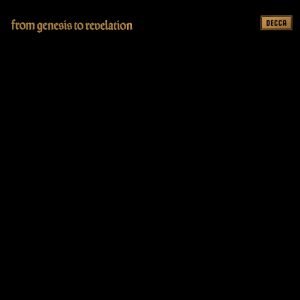Genesis’s From Genesis to Revelation stands as an intriguing footnote in the band’s extensive discography, offering a glimpse of a group still finding its footing. Released in 1969, this debut album is far removed from the theatrical prog-rock epics and arena-filling grandeur that would later define Genesis’s career. Instead, it exists in a peculiar space—a folk-inspired pop album steeped in lush orchestral arrangements, aiming to carve out a conceptual narrative about the creation and evolution of the world.
In the broader context of the late 1960s, the album feels like an oddity. It neither fully embraces the burgeoning progressive rock movement, spearheaded by bands like King Crimson and Pink Floyd, nor does it completely align with the more mainstream psychedelic pop aesthetic of the era. Instead, Genesis’s debut echoes the baroque pop stylings of artists like The Moody Blues or Bee Gees, but with a noticeable layer of precocious ambition.
The band—composed at the time of teenagers Peter Gabriel, Tony Banks, Mike Rutherford, and Anthony Phillips—worked under the guidance of producer Jonathan King, who heavily influenced the album’s direction. King envisioned a cohesive, concept-driven work, yet the execution often reveals a group constrained by inexperience and overreach. Genesis aimed to marry introspection with grandeur, crafting an album that tells a grand story of humanity and nature while retaining an air of youthful sincerity.
However, the result often feels more like an earnest attempt at sophistication rather than a fully realized artistic statement. The orchestration, layered over the band’s arrangements, sometimes clashes with the stripped-down intimacy of the songwriting, making the album feel unfocused. This tension between ambition and execution sets the stage for what would become a hallmark of Genesis’s early work, though here it manifests in a less refined form.
Sonic Exploration

The production of From Genesis to Revelation is emblematic of its time, offering a polished yet somewhat dated sound that leans heavily on Jonathan King’s vision for a conceptual, symphonic pop album. The recording is clean and precise, with a noticeable emphasis on the orchestral arrangements that overlay nearly every track. While this approach brings a cinematic quality to the album, it often feels overly saccharine, occasionally drowning out the youthful charm of the band’s core instrumentation. The result is a production style that strives for grandeur but often undermines the raw intimacy of Genesis’s early songwriting.
Musical Arrangements
Musically, the arrangements are ambitious, if uneven. The instrumentation prominently features delicate acoustic guitar lines, subtle piano flourishes, and Peter Gabriel’s earnest, if still-developing, vocal delivery. Tracks like “The Silent Sun” showcase a charming interplay between melody and orchestration, blending sweeping strings with folk-inspired pop sensibilities. However, in other moments, the dense layers of strings and horns feel more like a barrier than an enhancement, smothering the emotional nuance of the band’s performance.
Vocally, Peter Gabriel hints at the expressive range and dramatic flair that would later define his career, though here it feels restrained, perhaps due to the album’s more formalized arrangements. Harmonies are carefully crafted but lack the boldness that would later become a Genesis hallmark. The rhythm section, while competent, rarely breaks new ground, functioning more as a backdrop for the more prominent melodic and orchestral elements.
Genre Elements
From a genre perspective, the album resides in the intersection of baroque pop and folk rock, with faint hints of the progressive tendencies that Genesis would later embrace. Tracks often feature pastoral, folk-inspired melodies wrapped in lush, almost operatic string arrangements. While the album occasionally flirts with psychedelic pop motifs—particularly in its use of abstract, poetic lyrics—it never fully commits to the trippy, boundary-pushing ethos of its contemporaries. Instead, it adheres closely to a structured, concept-driven format that feels more aligned with the ambitious pop experimentation of The Moody Blues or early Bee Gees than the chaotic innovation of the late-’60s counterculture.
Lyrical Analysis

The lyrics on From Genesis to Revelation present a youthful yet ambitious attempt to grapple with grandiose themes. The album’s central narrative revolves around creation, life, and the evolution of humanity—a sprawling concept that aligns with its title’s biblical allusion. From the opening tracks, the band seeks to explore the cyclical relationship between nature, love, and existence, creating a thematic framework that feels both earnest and slightly overwhelming for a debut.
Recurring motifs of beginnings and endings, light and darkness, and love as a transformative force populate the album. For instance, “In the Beginning” introduces the listener to a creation story tinged with optimism and discovery, while tracks like “The Serpent” reflect on temptation and moral ambiguity. These biblical overtones don’t adhere to a strict religious narrative; instead, they function more as a poetic lens through which the band explores universal human experiences.
Lyrical Depth
Lyrically, the album straddles the line between poetic abstraction and straightforward storytelling. While some songs, like “The Silent Sun,” lean on conventional love song tropes, others, such as “Fireside Song,” offer more vivid imagery and introspection, painting pastoral scenes that evoke an almost mythic quality.
In terms of depth, the lyrics often reveal the limitations of their creators’ age and experience. There’s a notable precocity in the band’s attempt to tackle profound themes, but the execution sometimes lacks nuance. Lines can feel clunky or overwrought, as if reaching for a profundity that isn’t fully realized. That said, moments of genuine emotional resonance do shine through, particularly in the more introspective tracks, where the simplicity of the lyrics pairs well with their underlying sincerity.
Emotional Impact
The emotional impact of the lyrics is tempered by their ambitious scope. While individual moments evoke a sense of wonder or contemplation—such as the gentle optimism of “Where the Sour Turns to Sweet”—the overarching narrative can feel scattered, with some songs contributing more directly to the conceptual arc than others. This inconsistency can make it challenging to fully immerse oneself in the album’s intended emotional journey.
Cohesion and Flow

The flow of From Genesis to Revelation reflects both the strengths and weaknesses of its conceptual ambitions. On one hand, the album is structured to tell a broad, overarching narrative, ostensibly following a progression from creation and innocence to corruption and reflection. This thematic intent is apparent in the track sequencing, with early songs like “Where the Sour Turns to Sweet” welcoming listeners into the album’s universe with a gentle, almost hymn-like tone, while later tracks such as “In Hiding” and “Am I Very Wrong?” shift toward introspection and existential questioning.
Despite this effort to maintain a narrative arc, the album’s actual flow can feel disjointed. The transitions between tracks don’t always serve the broader concept, as some songs seem to exist in isolation rather than as integral pieces of a cohesive story. For example, while the orchestral interludes attempt to create a sense of unity, they can sometimes feel more like decorative flourishes than meaningful bridges between songs. This undermines the album’s intended sense of continuity, making the progression feel more like a collection of loosely connected vignettes than a fully realized narrative journey.
Thematic Consistency
Thematic consistency is another area where the album both strives and falters. While the overarching ideas of creation, growth, and human experience provide a conceptual backbone, the execution varies significantly from track to track. Some songs, like “In the Wilderness,” align well with the album’s grand narrative, using vivid imagery and swelling arrangements to evoke a sense of awe and exploration. Others, like “One Day,” feel more like standalone love songs, thematically disconnected from the album’s broader scope. This inconsistency can make the album’s vision feel muddled, as if the band’s youthful ambition outpaced their ability to tie everything together cohesively.
Stylistically, the album’s baroque pop aesthetic provides a unifying sonic thread, but even this can feel uneven at times. The heavy reliance on orchestral embellishments creates a tonal consistency, yet it also highlights the tension between the band’s natural folk-rock sensibilities and the grandiose production choices. When these elements clash, as they often do, the flow suffers, creating moments where the album feels more like a tug-of-war between competing artistic impulses than a harmonious whole.
Standout Tracks and Moments
Despite the uneven execution of From Genesis to Revelation, several tracks and moments manage to shine, offering glimpses of the creativity and emotional depth Genesis would later refine. These standout elements provide both artistic merit and a sense of promise, even within the confines of the album’s overly orchestrated production.
Key Tracks
“The Silent Sun”
As the album’s lead single, “The Silent Sun” stands out for its melodic charm and heartfelt simplicity. Written in the style of a love song to appease producer Jonathan King, it blends folk-pop sensibilities with a lush, string-laden arrangement. Peter Gabriel’s earnest vocal delivery brings a sense of intimacy to the track, while Tony Banks’s subtle piano lines add a layer of sophistication. Though not groundbreaking, its restrained elegance makes it one of the more accessible and memorable songs on the album.
“In the Wilderness”
This track captures a dramatic intensity that distinguishes it from the album’s gentler offerings. The swelling orchestral backdrop complements the song’s themes of searching and survival, while the rhythm section provides a driving momentum. Gabriel’s impassioned vocals lend an urgency to the narrative, making it one of the more dynamic and emotionally engaging moments on the album.
“Am I Very Wrong?”
A reflective piece that showcases the band’s potential for introspective songwriting, “Am I Very Wrong?” offers a poignant blend of acoustic guitar and plaintive vocals. The lyrics grapple with existential uncertainty, a recurring theme throughout the album, and Gabriel’s delivery imbues the song with a sincerity that resonates beyond its lyrical simplicity.
Memorable Moments
The Transition in “Fireside Song”
The pastoral imagery in “Fireside Song” is brought to life through a gentle acoustic introduction that shifts into a more sweeping, cinematic arrangement. This transition highlights the band’s early attempts at dynamic storytelling through music, providing a moment of genuine emotional uplift.
Gabriel’s Vocals in “The Serpent”
“The Serpent” offers one of the album’s darker tones, with lyrics that explore themes of temptation and moral conflict. Gabriel’s vocal performance, tinged with an ominous edge, injects a theatricality that hints at the dramatic flair he would later perfect. The tension between the menacing lyrics and the somewhat over-polished production creates a strangely compelling contrast.
The Opening of “Where the Sour Turns to Sweet”
Serving as the album’s introduction, the gentle and almost hymn-like quality of “Where the Sour Turns to Sweet” sets a contemplative tone. The soft piano and Gabriel’s welcoming voice invite listeners into the conceptual world the band aims to build, making it an effective, if understated, opener.
Artistic Contribution and Innovation

When viewed within the context of its time, From Genesis to Revelation occupies an unusual place in both the music industry and the emerging landscape of late-1960s rock. Released during a period of immense musical experimentation and innovation, the album makes an earnest attempt to blend the conceptual ambitions of progressive rock with the accessible melodies of baroque pop. However, its contributions feel more like tentative steps than boundary-pushing leaps, reflecting a band still finding its voice within a crowded and rapidly evolving scene.
Place in Genre and Industry
At the time of its release, the album was overshadowed by more audacious works from contemporaries. Bands like King Crimson, Pink Floyd, and The Nice were beginning to redefine rock’s potential by merging it with avant-garde, jazz, and classical elements. While Genesis’s use of orchestration hints at similar ambitions, From Genesis to Revelation remains firmly grounded in a pop-centric approach, lacking the daring complexity of its peers. The album also arrived at a moment when concept albums were gaining traction, yet it adheres more to the stylistic norms of the late-1960s baroque pop movement, aligning it more closely with artists like The Bee Gees or The Moody Blues than the trailblazing experimentation of progressive rock pioneers.
Commercially, the album struggled to find an audience, in part due to marketing missteps. Its title and biblical themes led some to mistake it for a religious record, further complicating its reception. While this obscurity may have hindered its immediate impact, the album remains an interesting artifact for fans of Genesis and a curiosity within the broader genre.
Innovation
Despite its limitations, From Genesis to Revelation does demonstrate flashes of innovation, particularly in its conceptual ambition. The idea of crafting an album-length narrative about creation and humanity’s journey, especially as a debut, reflects a boldness that was not yet commonplace in rock music. This thematic exploration, while uneven, hints at the storytelling prowess that would later define Genesis as one of the foremost bands in progressive rock.
The orchestral arrangements, while heavy-handed, also point to the band’s willingness to experiment with genre-blending. The integration of classical instrumentation into a folk-pop framework, though not entirely novel, adds a layer of sophistication that sets the album apart from more straightforward pop efforts of the era. In tracks like “In the Wilderness” and “Fireside Song,” the dramatic interplay between strings and the band’s core instrumentation suggests a burgeoning interest in dynamic contrast and atmosphere.
Thematically, the album’s exploration of creation, morality, and human frailty hints at the intellectual depth Genesis would later bring to their work. While the execution lacks the finesse of their subsequent albums, the ambition to tackle such weighty topics within a conceptual framework was a noteworthy departure from the typical themes of love and heartbreak that dominated pop music of the time.
Closing Thoughts

From Genesis to Revelation is a debut album that captures the early stirrings of a band brimming with ambition but still searching for its identity. It reveals both the promise and the limitations of Genesis in their formative years. The album’s strengths lie in its thematic ambition, melodic charm, and moments of heartfelt sincerity, particularly in tracks like “The Silent Sun” and “In the Wilderness.” These elements hint at the storytelling depth and musical sophistication that would later become the band’s hallmark.
However, the album is hampered by its heavy-handed orchestration and an inconsistent execution of its grand conceptual framework. The tension between producer Jonathan King’s vision of a baroque pop masterpiece and the band’s emerging progressive rock sensibilities creates a disjointed listening experience. Additionally, while the lyrical themes are ambitious, their depth is often undermined by a lack of nuance, reflecting the inexperience of the band at this early stage.
For listeners, the album offers a fascinating glimpse into the genesis of Genesis—pun intended. It is not an essential entry in their catalog, but it provides valuable context for understanding the evolution of one of rock’s most iconic bands. Fans of baroque pop or those curious about the early seeds of progressive rock might find From Genesis to Revelation to be a worthwhile exploration.
Official Rating
This album earns a 7 out of 10 for its bold thematic ambitions and moments of melodic beauty, tempered by its uneven execution and lack of cohesion. While it falls short of being a groundbreaking work, it deserves recognition for its earnest attempt to fuse conceptual storytelling with accessible pop sensibilities. More importantly, it serves as a stepping stone, marking the first chapter in the career of a band that would go on to redefine progressive rock. For all its flaws, From Genesis to Revelation remains an intriguing and important piece of Genesis’s history.
